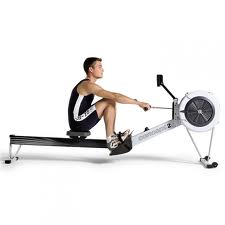The erg (or ergo or rowing machine) is the next best thing to rowing a boat as far as training rowers is concerned – and arguably better than the boat for measuring a rower’s power output accurately and repeatably. Sadly, for too many rowers, the erg is an instrument of torture to be avoided if at all possible.
From the coach’s point of view, the erg is just too valuable to be left out of the training programme so it is part of our job to make it less intimidating to the less-than-elite rowers who make up the majority of most clubs. I find the following approaches helpful:
- Coach your rowers on how to use the erg. It is an ideal platform for rehearsing the shape and sequence of a correct rowing stroke. A surprising number of rowers are self-taught on the erg and use very poor technique, so wasting hours of training which could have been used to build useful ‘muscle – memory’.
- Ask rowers to do their erg sessions in groups, ideally following ‘stroke’. Just as marching makes walking long distances easier, rowing together makes a 30 minute piece easier.
- Make it a rule that rowers have a 2 minute rest off the erg to stretch and take a drink after a maximum of 30 minutes exercise.
- Have each rower keep a personal record of their erg performance so that they know exactly what level of performance they are aiming for on every erg session.
- Vary the erg programme with short sprints, long UT2 sessions, 1k, 2k and 5k pieces. Use the Concept 2 website occasionally for their ‘Workout of the Day’ (http://www.concept2.co.uk/indoor-rowers/training/wod).
Indoor training at most clubs is centred on the erg and as with so many other exercise options, frequency beats intensity. It is an excellent route to fitness and deserves to be used to best effect.


Agree except for point 5, 1k is fairly pointless unless you do 6-12 of them, and the workout of the day aren’t good they’re usually crap and don’t follow a particular training plan
I disagree. Most UK regattas courses are about 1k. Sprint events are 500m. As for the Concept 2 ‘workout of the day’ I’d use them as extras, not part of a core programme.
Ergs are used predominantly in building the base level of fitness, so during the winter building for 5-7km head races, then when you go for 2k regattas (met/marlow, Henley etc) you switch to 6 x 500m and similar for sprints, you’re right shorter regattas are out there at the end of the season but then you switch to doing everything in the boat, cos pot hunting is all about the start
I don’t think anyone has time for extras! A training plan is either one session a day or two, ergs and weights. And then water. I’ve never had someone looking for extras outside the training plan
Oh, and erg tekkers is usually different to boat tekkers cos you don’t have to tap down or move the hands to one side. It’s very good for building lower leg strength, cardio endurance, and timing when in groups, but a “technical erg” is rarely useful
Just because you don’t *have* to tap down (or keep your knees down on the recovery) doesn’t mean that it isn’t useful to do so. Unless indoor rowing is ALL you do (and there are such people) using the erg to practice the movements of the stroke cycle makes perfect sense. AND it gives you something else to think about.
But you hold the erg handle different to a blade because you don’t feather it. You don’t have the instability of the boat to worry about, you don’t have to split the leg in the same way (ie drop the outside knee to fit your arm through) you don’t have the rotation and you don’t lift your arms into the catch. Because ergs are used to measure fitness your tekkers is lined up for maximum score, which is why people don’t bother looking at the power curves, and use the upper body to get a couple of extra pips to get a better score, as not many coaches look at erg tekkers because they can do that in the boat. It’s almost like rowing is different to sculling is different to erging, it’s just a different style that uses the same muscle groups.